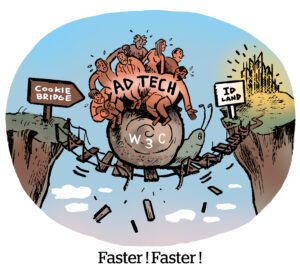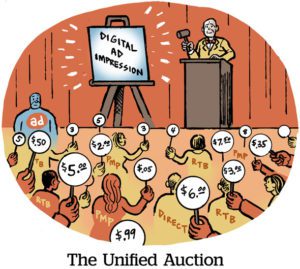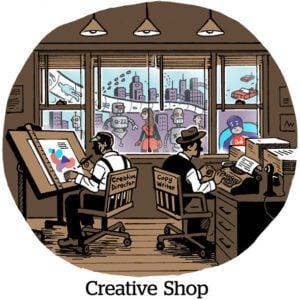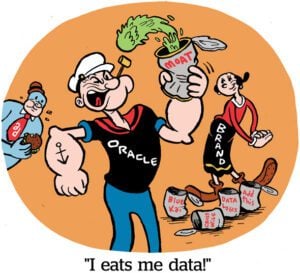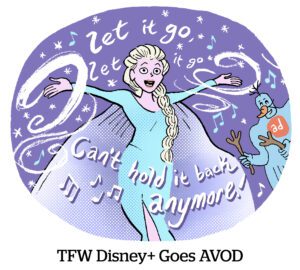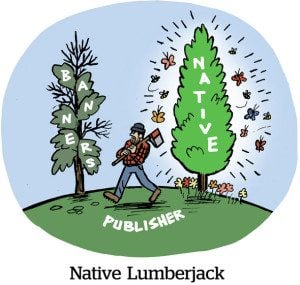G/O Media knows all too well about the headwinds facing digital publishers. And it’s betting a contextual targeting offering will help it recover from a dismal ad market in 2023.
The company embodied last year’s challenging media environment. It underwent two rounds of layoffs in June and November, shuttered Jezebel, sold Lifehacker to Ziff Davis and finished the year in the red.
CEO Jim Spanfeller has denied rumors that the company is looking to sell off its entire portfolio. But the company has reportedly fielded inquiries from buyers interested in its flagship brands, Gizmodo and The Onion – the “G” and “O” in G/O Media. Spanfeller appeared to confirm that the company is participating in talks with potential buyers, but did not specify which brands were on the table.
G/O Media’s disappointing 2023 was largely due to weakness in the digital ad market.
But the company is optimistic about renewed advertiser interest in contextual targeting, which has long been a focus of its direct sales efforts, said Lou Tosto, SVP of advertising sales, programmatic and ad products.
To lean into that opportunity, G/O Media announced Thursday it’s introducing a new contextual targeting solution called Veritas Plus. The targeting tool combines first-party contextual signals and data on audience browsing behavior to create cross-site contextual segments that can be activated programmatically.
However, time may be running out for G/O Media, which is now about five years removed from its acquisition by private equity firm Great Hill Partners. It’s approaching the typical expiration date at which PE owners begin rethinking their investments, Spanfeller recently told Axios.
G/O’s new efforts at generating ad revenue could be the deciding factor as to whether its remaining properties get sold off or not.
Content- and user-based targeting
Veritas Plus is an upgrade to G/O Media’s existing Veritas CMS, which the company introduced in 2021 as a way for its editors to manually categorize its inventory and audiences.
The new solution allows advertisers to programmatically purchase the contextual segments that G/O Media has spent the past three years building, in addition to buying them through direct deals.
With this product release, G/O Media joins a spate of publishers, including Vox Media, Dotdash Meredith and Axel Springer, that are doubling down on contextual as a way to generate more business and future-proof against third-party cookie deprecation.
Veritas Plus will offer 15 segments to start, with plans to add more. Categories include tech enthusiasts, movies and entertainment, “foodies,” gaming, humor, multicultural thought leadership, business decision makers, beauty, travel and health.
Inventory is grouped together across domains at the site level. For example, Gizmodo and Quartz are under the tech umbrella.
But advertisers can also target users that fit into these interest-based categories as they browse other sites in G/O’s portfolio. For instance, if a user consistently reads tech content on Gizmodo and Quartz, that person might be placed into the tech enthusiast segment and later be targeted on The Root, which is a general interest publication geared toward Black audiences that doesn’t have an explicit tech focus.
Buyers also have the option to restrict certain sites from their campaigns.
The programmatic pitch
For now, these contextual categories will only be sold through programmatic guaranteed and private marketplace deals, rather than open auction, Tosto said. Advertisers can buy the segments directly from G/O Media, or through a DSP and SSP of their choice.
The new solution takes the publisher’s longtime approach to its direct sales business and adapts it for programmatic activation to take advantage of growing demand for contextual targeting, he said.
The goal is to drum up business from new advertisers and get them to keep spending, according to Tosto. G/O Media hopes it can replicate the success it’s seen in retaining existing advertisers – it claims to have had a 70% advertiser retention rate in 2023 – with a new pool of ad buyers.
G/O Media also expects that Veritas Plus will grow the share of ad revenue it generates from programmatic.
Across its entire portfolio, G/O Media currently sells roughly 70% of its ads through direct deals and about 30% programmatically, Tosto said. The programmatic slice of the pie is more or less evenly split between open auction, programmatic guaranteed and private marketplace deals.
Turnaround tactics
Contextual targeting is just one way G/O Media is attempting to boost its ads business.
The publisher is also working with marketers to overcome brand safety barriers that have prevented it from monetizing certain inventory in the past, and Veritas Plus is part of that solution.
For example, Jezebel’s editor-in-chief, Lauren Tousignant, has been outspoken about how brand safety restrictions spurred G/O Media’s decision to cut ties with the publication, which was later acquired by Paste Magazine.
G/O Media now is working on categorizing its content according to sentiment, as an alternative to keyword blocklists. The company will still honor advertiser blocklists, Tosto said, but it’s also educating buyers on how blocklists have unintended consequences and how sentiment analysis can be a fairer approach to avoiding bad ad adjacencies.
Time will tell if these new initiatives can reverse the company’s fortunes. Publishers in general are under increasing economic pressure, and the clock is ticking on G/O Media’s revenue turnaround.
Update 2/29/24: G/O Media’s position on potential acquisitions of its flagship brands has been clarified. A previous version of this story said CEO Jim Spanfeller confirmed the company is in acquisition talks with buyers interested in Gizmodo and The Onion. Spanfeller did not specify that the conversations G/O has had with potential buyers included acquisitions of those two properties.




